-
Posts
5,374 -
Joined
-
Last visited
-
Days Won
15
Posts posted by LongLeftFlank
-
-
...And while I'm thinking about European urban areas, an iron railing (a low stone or brick wall topped by a spiked rail that men can't hop across without breaching) seems like a pretty ubiquitous feature.
The other most common city feature missing at present would be a solid flavour object representing a flight of steps 1-2 meters up to a townhouse. Good solid cover for men fighting in the streets. Making these steps climbable would be even better! -- so mapmakers can sink the ground floors of certain buildings into half basements and let troops enter the second floor directly (hint: you can already "fake" this with a Bridge object!). But that's a wishlist feature.
For the older districts of Gay Paree, a collonaded balcony type would also provide an interesting building facade with tactical properties -- at first floor, instead of posts reaching to the ground you have thick stone pillars and arches (providing solid cover).
-
Actually, while we're here, can we expect any new goodies in the way of map / terrain types in the CW module?
While I'd love a ground level LOS blocking "thicket" or "high dense brush" tile, what about a flat-roofed industrial building type? (accessible roofs a la CMSF, grimy brick construction and high bays -- basically a "barn" variant). The Caen area was somewhat more developed industrially than the US Basse Normandie sector; we must also start thinking about the Breakout, Falaise and Leclerc's Liberation drive for/into Paris.
A nice to have would be a black iron "fire escape" balcony type.... Doesn't have to be an exterior stair although this would rockn if Charles is feeling bored (yeah, right!). You might also want a "long window" that doesn't include a door; prewar factories were big on natural daylight to save lighting costs.
Railway rolling stock would be way cool too for railway station / / marshaling yard fights.
A (no climbing no LOS nightmare) smokestack flavour object would also look awesome! (thinking it would be a kind of tree so it would cast a shadow and absorb some fire)
A few cover-providing industrial flavour objects off the top of my head might include: large industrial vat (wood and cast iron), drill press or lathe, burnt out civilian lorry, large stack of railroad ties or lumber, kiln/furnace (basically a large brick fireplace with a metal hatch).
-
Behind Enemy Lines/BAT 21 - you'll have to have a mod of Gene Hackman's face or maybe Owen Wilson's.
Make 'im an Elite FAC and his squadron can try to cover him a la BAT-21 or Bridges at Koto-Ri. (whose Mickey Rooney in a top hat mod are you using?)
Feliz Navidad, all!
-
I have to work tonight (as in, the job that pays the bills -- just call me Bob Cratchit) but I did have one "a-ha" moment when viewing my CMBN handiwork at ground level.
The only parts of these settlements that are generally visible at any distance are the rooftops. Which make good aiming points for artillery, since you can see spotting rounds -- especially mortars -- impacting on them. Which may be a really good practical reason why buildings (at least highly visible ones) were NOT favoured as defensive positions in the bocage, regardless of how thick and protective their walls might have been.
And in that vein, those of you who have become accustomed to locating an enemy MLR and then plastering it with artillery or AFV direct fire before mopping up will be in for a bit of a shock on my map. Good luck getting LOS to an enemy position without walking right up to it. There's a reason FOOs had the shortest shelf lives of any personnel in the Allied forces.
-
And one by one, the little Norman hamlets and farmsteads appear, enshrouded behind overgrown walls, bocage and orchards. All these have been carefully laid out in their authentic Google Earth footprints, with reference to the 1947 shots. Most of the buildings are unchanged today although the bocage has been largely removed.
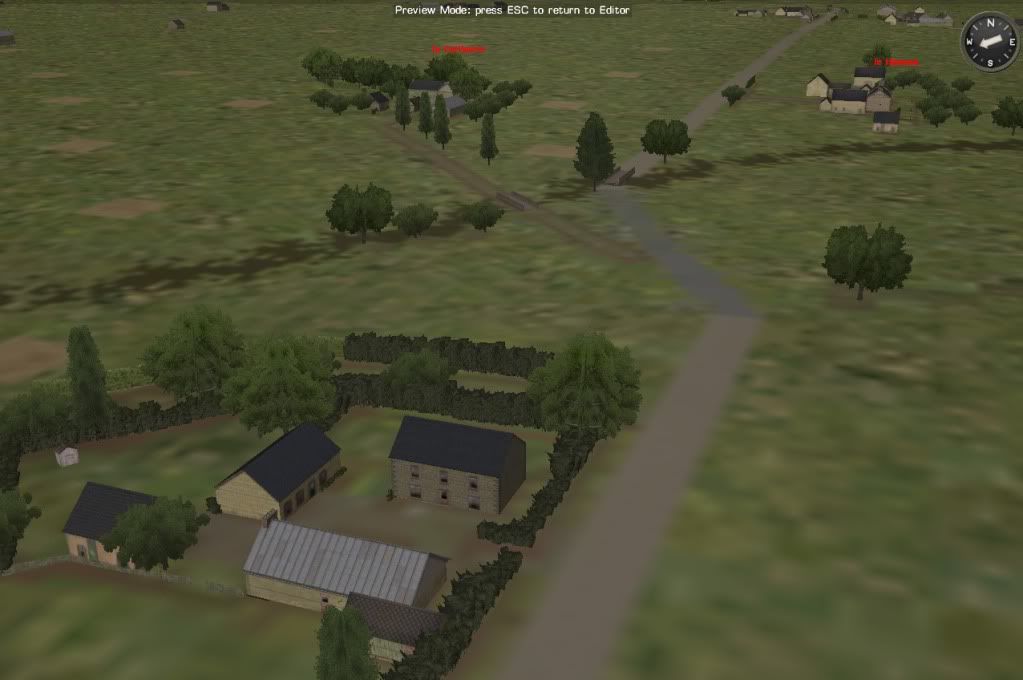

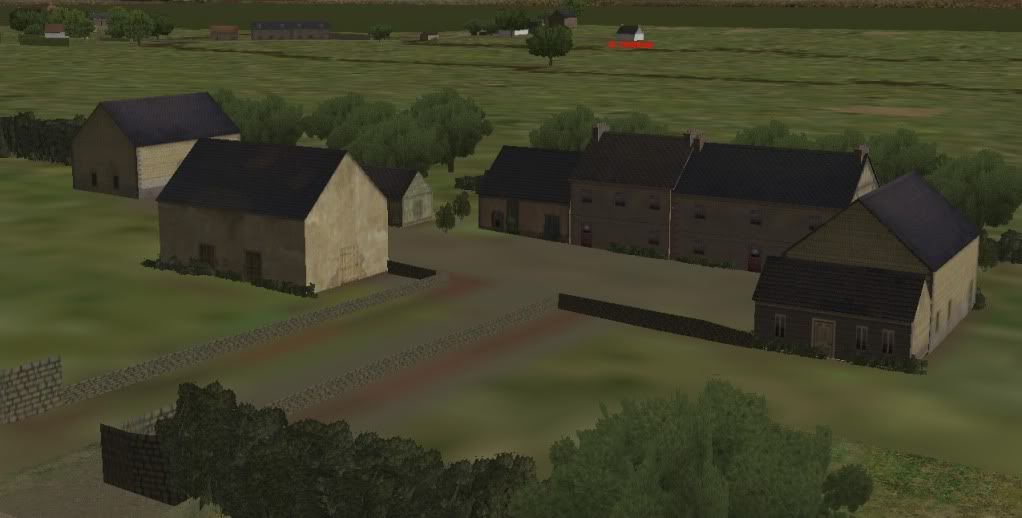
La Caillourie -- innocent looking, but shields the entrance to a tactically critical sunken road....
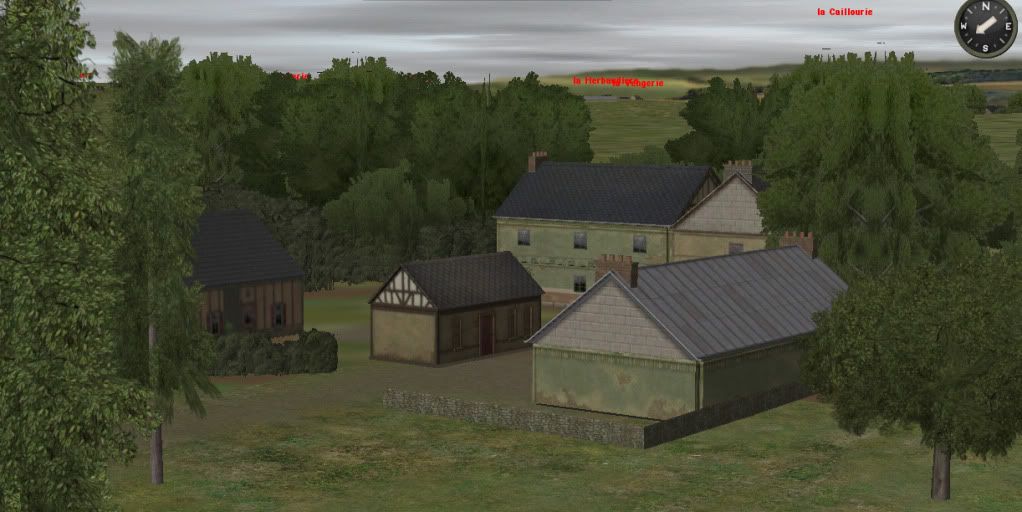
The manor farm at Launay, first waypoint along the advance route of 2nd Battalion, 137th, toward the fortified heights at Le Carillon, June 10. INCOMING!!!!!!!!!

If you're curious, these villes take about an hour apiece to lay out, using two computers -- one with CMBN open and the other with (a) Google Maps / Streetview (
 the 1947 image in GIMP © my gallery of buildings so I can match the textures and door/window placements as closely as possible.
the 1947 image in GIMP © my gallery of buildings so I can match the textures and door/window placements as closely as possible.And I'm not fishing for compliments here, just sharing ideas with my fellow map designers.
-
I'm waiting for BFC to offer a discount for Brits + NATO only and then I will buy them.
-
Well by the time I finish my monster bocage map I'm hoping you'll all be sick to death of Holland and want to go back to it for a bit.
-
This is partly a map design issue; frankly, tanks should not normally be able to pull in behind stands of mature trees and fight through them in summer. Low branches and thickets of smaller trees on the edge of the wood would make LOS largely impossible. Keyholing through a gap is a different matter. An AFV in a fighting position in woodlands is generally concealed in brush, not sitting amid trees; the latter is a hiding place from air power. There are exceptions, sure, but not the rule.
-
It simply needs to link to a low stone wall that's in the action square occupied by the tower. The "follow the wall" movement logic seems to override the "don't climb cliffs" logic which is how the units scale the Pont du Hoc cliffs (hedges, not walls in that case). I use a right angled tile to provide egress to both the church building and the churchyard although I havent checked the former configuration yet.
Units in the base tower level can exchange fire with adjacent units in the churchyard.
I also played around with laying a 16m footbridge through the middle of the tower to let units enter at the higher level. This works, but only one-way... Once the units "realize" they are in the church tower, they won't go back onto the bridge.
-
The church tower at St Martin was a linchpin for the German defense at La Meauffe. Its thick sandstone walls provided solid cover for artillery observers and a machine gun nest dominating hundreds of meters of surrounding fields. There's a smaller bell tower across the river in the chapel at Bahais that served a similar role for both sides.
It just won't do to have these critical positions simply leveled by a bunch of 81mm rounds early in a game (FOs and gunners can be replaced but good overwatch is scarce on this map). However, the shell-resistant 8 story cathedral tower provided with the game is too damn tall for a rural church -- it looks like there should be a giant flaming eye on the top.
Here's my solution; bury it 5m deep in the ground and steal Seabee's Pont du Hoc trick of having a small stone wall that helps troops climb in and out of the pit. The ground level also makes a solid bomb shelter (the godless Huns had heavily fortified this church and the adjacent chateau with poured cement pillboxes, etc.)
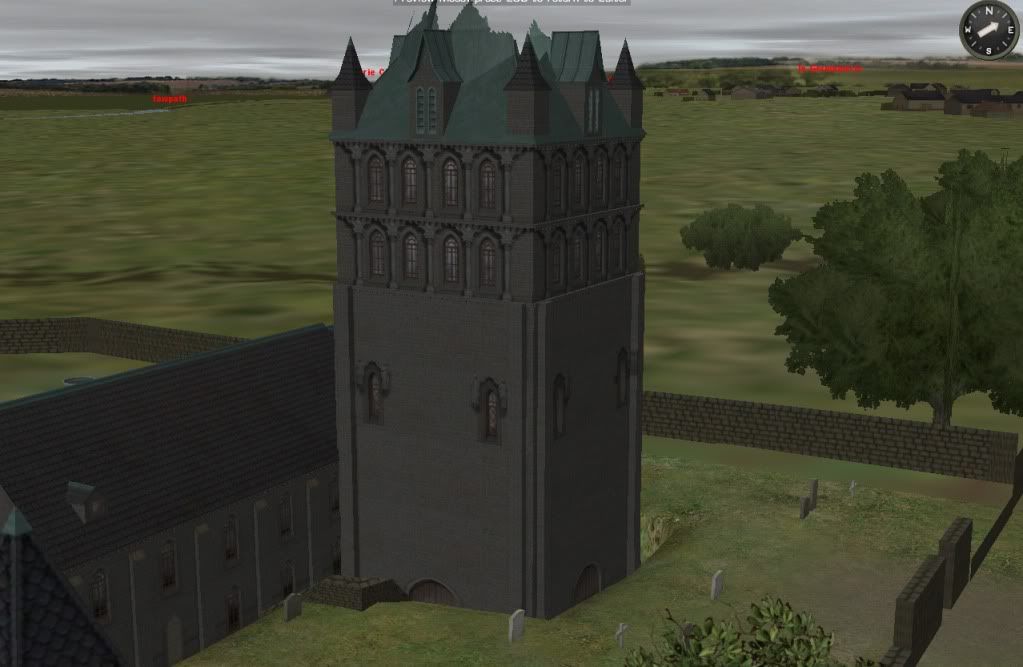
Notice I buried the church 1m as well, to give troops a "half basement" level to fight out of.
-
They still default to the same height as all the other water tiles on the map though. So you end up with tiny streams in massive ravines.
-
Thanks, Erwin. I hope you'll be as productive a playtester for this map as you were for Joker 3.
And as to feeling "sorry" for me -- well, I'm able to earn a reasonable living using roughly the same personality disorder as I'm applying here for pleasure.

But enough chit-chat; here's another fidelity check. I decided to build out a stretch of the Vire river bank due west of the railway station. While using the 1947 Mosquito shot as authoritative, I also drew on a contemporary photo embedded in Google Maps:

After a couple hours of the aforementioned obsessive tweaking, here's my version (sorry about the low res patch in the background -- I had to dial my settings way back to get the map to preview):

A lot of the tweaking had to do with the angle of the river banks. This stretch of the Vire is 3 squares wide (~24m) and using 3 pure Water tiles gives a very steep "cliff" embankment which is an inhospitable surface for the vegetation that should be growing right down to (and sometimes into) the water.
Using one Water tile with a Deep Ford on each side gives me a pretty authentic angle (you can be the judge). For long "straight" stretches of river, I also occasionally mix it up by using a couple of Shallow Ford or Water tiles instead -- this makes the riverbank look more natural.
The next step was getting the right vegetation on the bank. Here's my secret sauce, for those interested:
1. Most adjacent tiles are Light Forest, with occasional patches of Heavy Forest, XT Grass, Marsh (plus Shallow Ford water adjacent) or other (weeds, etc.)
2. About half the riverbank tiles also contain a "gapped" Bocage, Low Bocage or Hedge object placed at a random angle so as to look like a naturally growing bush or thicket and authentically inhibit LOS.
3. The Vire was a "working river" (canal) until the early 20th century and had a towpath on both banks. Although these were disused and overgrown by 1944, most of the regrowing trees were (and are still) relatively small.
4. I haven't laid the hedgerows on the bordering fields yet, so except for the chapel at Bahais (center), the areas away from the Vire still look a little barren.
-
Low-res shot of La Germainerie la Meauffe, showing the primary American axes of advance: along the Vire, Route 3 and the rail line. Most of the building and farm complexes in town are now done and I'd shortly like to start building a "prelude" scenario (Baker Co. 1/119's fight to secure this area on June 18), using a submap.
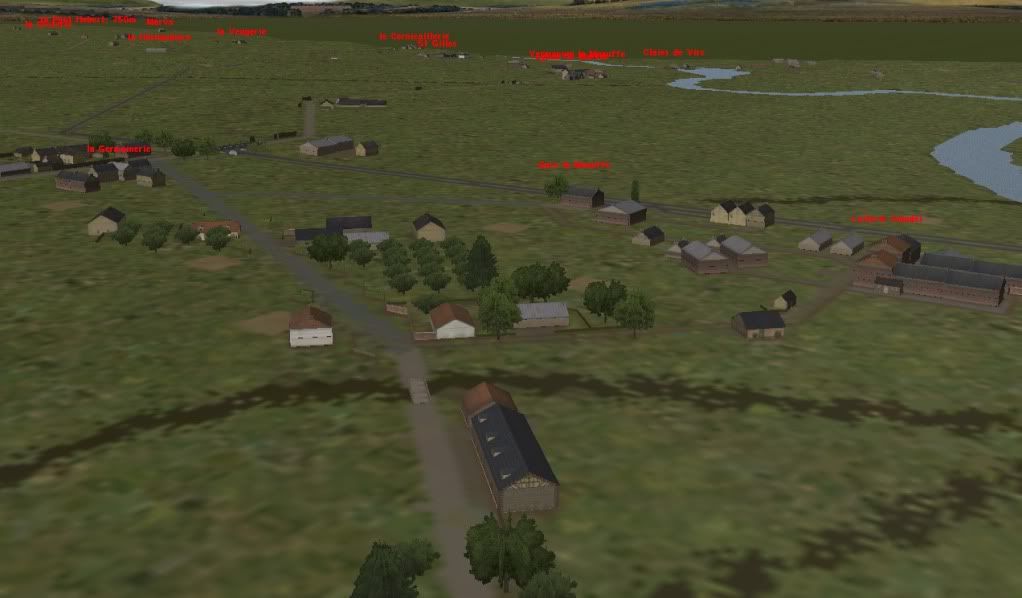
-
La Caillourie, one of those little Norman hamlets on the banks of the Vire whose rooftops are barely visible above the bocage.
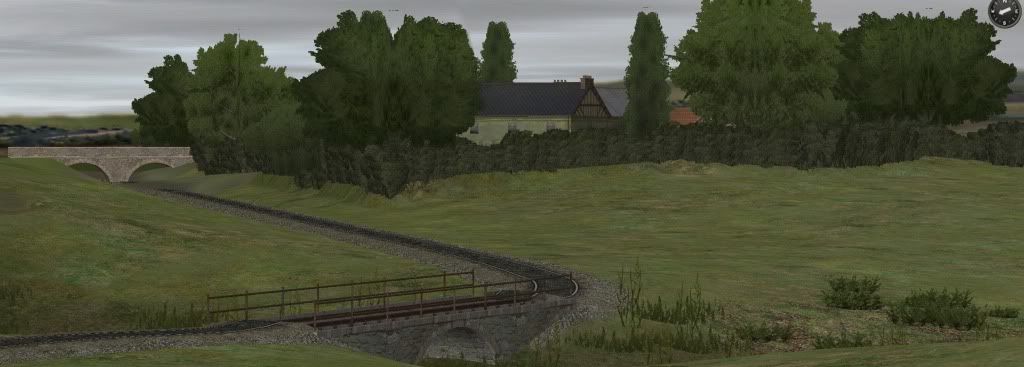
-
Put [img ] pic.jpg [ /IMG] around the images (delete those extra spaces) and we can see then without clicking links
-
And cockney accents for all the NCOs
Careful... Just to spite you, they'll have all the voices done by Dick Van Dyke!
-
Really? I've found brush to be worthless for concealment purposes.
-
Good discussion here and if you haven't fought Broadsword's la Nicollerie map yet, you definitely should. I personally think of it as CMBN "as it oughta be", but your own MMV.
One real revelation as I flesh out my le Carillon monster map (building farmsteads and their immediately surrounding terrain -- slowly) is that there is a wealth of natural dead zones and blind spots, both natural (irrigation ditches and wider stream draws) and manmade ( like rail cuts and embankments). A smart attacker will seek these out, but a smart defender will mine, defilade and TRP them! Definitely a critical and challenging third dimension missing from many of the "pooltable" maps.
-
Bug...Bug!!!!!!!! This sir is a FEATURE!
Actually, I was kind of disappointed it went away so easily, since I was looking for a way to synthesize a hovering helo gunship in CMSF using a suitable light AFV (TOWs for Hellfires, etc.). Other than as an OBA module that is.
-

Ever notice th' funny sound those new zippers make, Willie?
-
Had flying Ali-Babas in CMSF too. Iirc, if you select a unit on a rooftop and then flip the camera view tomax elevation then back again, theunit floats. The bug goes away if you save and reload
-
Towers are like trenches, foxholes and bocage. They're slaves to the underlying action square grid which the whole game runs on. There's a minimum size inhabitable building footprint. Catherdal tower, last time I checked, was the same footprint as a smallest square building (though it looks bigger). Any smaller and some of your squad will be hanging around out of doors because everybody can't fit in together.

CMBN did add a couple of little barn objects less than 1x1 in size, so it's clearly feasible... Just tricky to make work, I expect, for reasons you cite and maybe others too. As to the issue of excess personnel hanging around outside, all the better, since you wouldn't want units of more than 3 entering in the first place.
-
An intermediate-sized bell tower (distinct from the 8 floor cathedral spire) is sorely missed, just as minarets were conspicuously missing from CMSF. The small square building type is an imperfect substitute for either, owing to its carrying capacity.... A 3 man MG or FOO team is about all you'd expect to fit in a church tower. I thought BFC could work up a special "bunker" type fortification (these are basically an immobile vehicle) with a multistory "turret" but they have other priorities.
-
Unless his last name is Scott or Uhura, he's a goner. And I don't see no earrings.



realism of mortars
in Combat Mission Battle for Normandy
Posted
As I've said several times in similar threads, I don't think the spotting, timing or accuracy of the mortars are the problem (although I think their blast effects on hard targets like buildings and bunkers are way overmodeled relative to conventional HE shells), it's the unrealistic lack of reaction of the human targets to the "Incoming!!!" before the impact. Even taking into account the relative quiet of falling mortars, giving men, especially Veteran and up, a split second to lie down flat and stay there would help a LOT with the lethality in all but the most coverless terrain. This is well documented in veteran accounts; hitting the dirt when Sarge does was Lesson One in battlefield survival for most replacements.
The primary WWII tactical purpose of mortars (tactical unit control, deployed near the the front, short range, high ROF, rounds and fuzing designed to trade blast effect for wide fragmentation) was to force large numbers of attackers to ground, bloodying, demoralizing, pinning and delaying them long enough to allow defenders to react and reinforce. And then to compel the pinned forces to withdraw to less exposed cover or be progressively peppered to death. The other purpose was "stonks"; harassing fire aimed at disrupting enemy activity such as resupply or entrenching.
In neither case was the expectation to annihilate entire enemy formations -- even entrenched ones --within minutes through intensive barrages, as happens in the game with depressing regularity leaving sad heaps of huddled corpses. Mortars were rarely in a position to create that kind of concentrated carnage unless the enemy was either somehow hemmed in (e.g. a gully) with lousy cover or blindly insisted on continuing to advance (banzai charge / human wave).
Yes, they were the most lethal weapon of WWII. No, they weren't capable of wiping out entire non-moving units to the last man within minutes. Didn't happen except in bizarre circumstances.